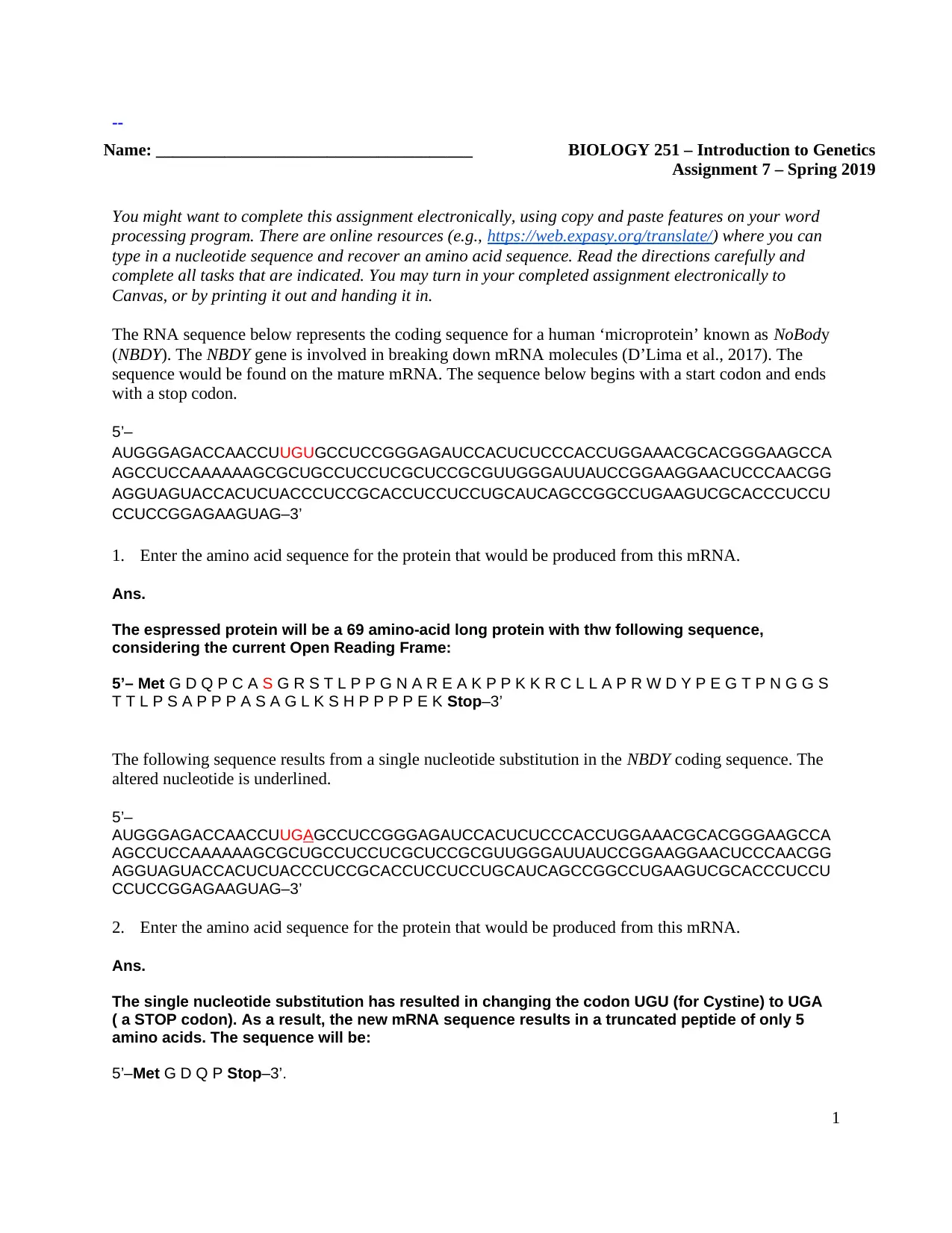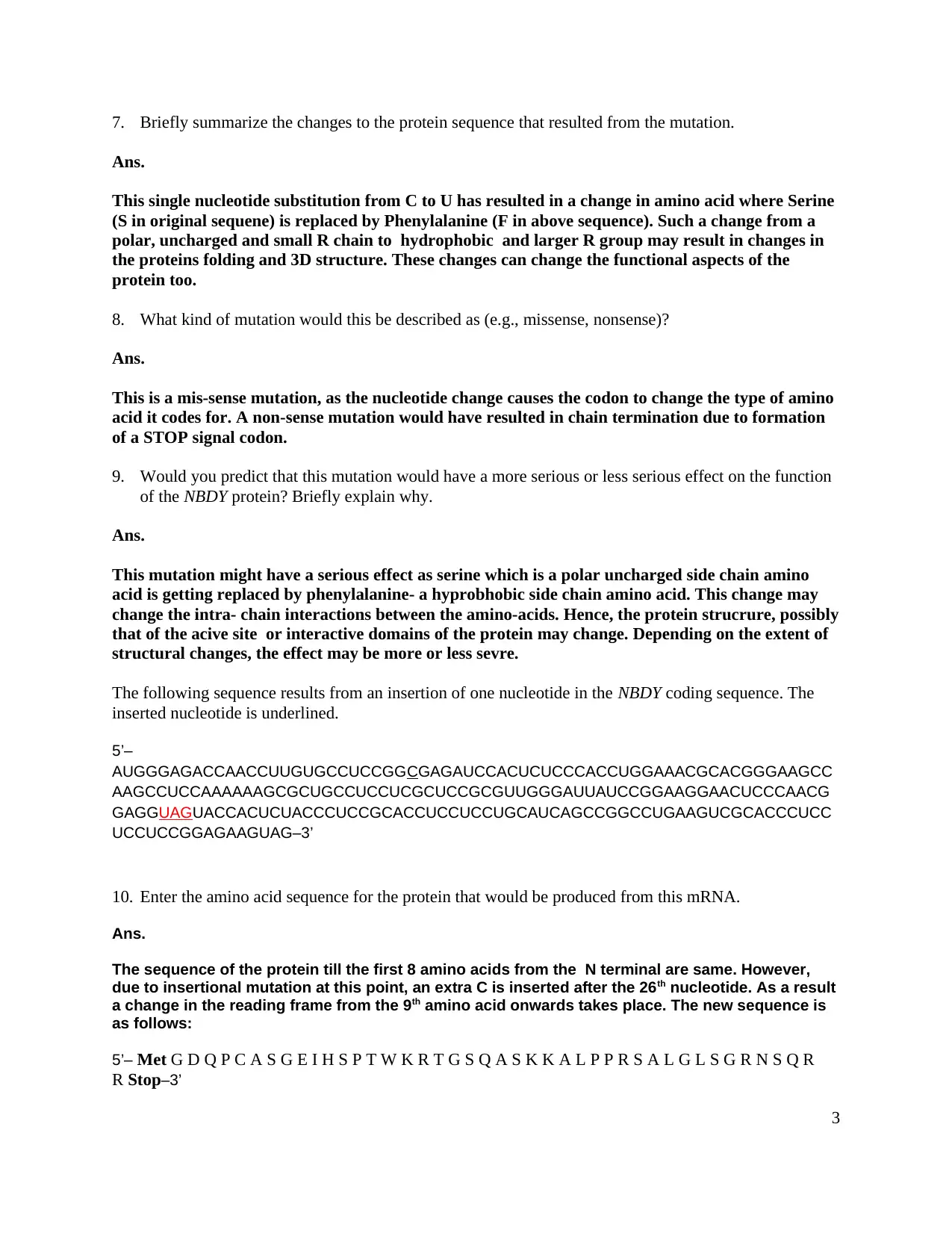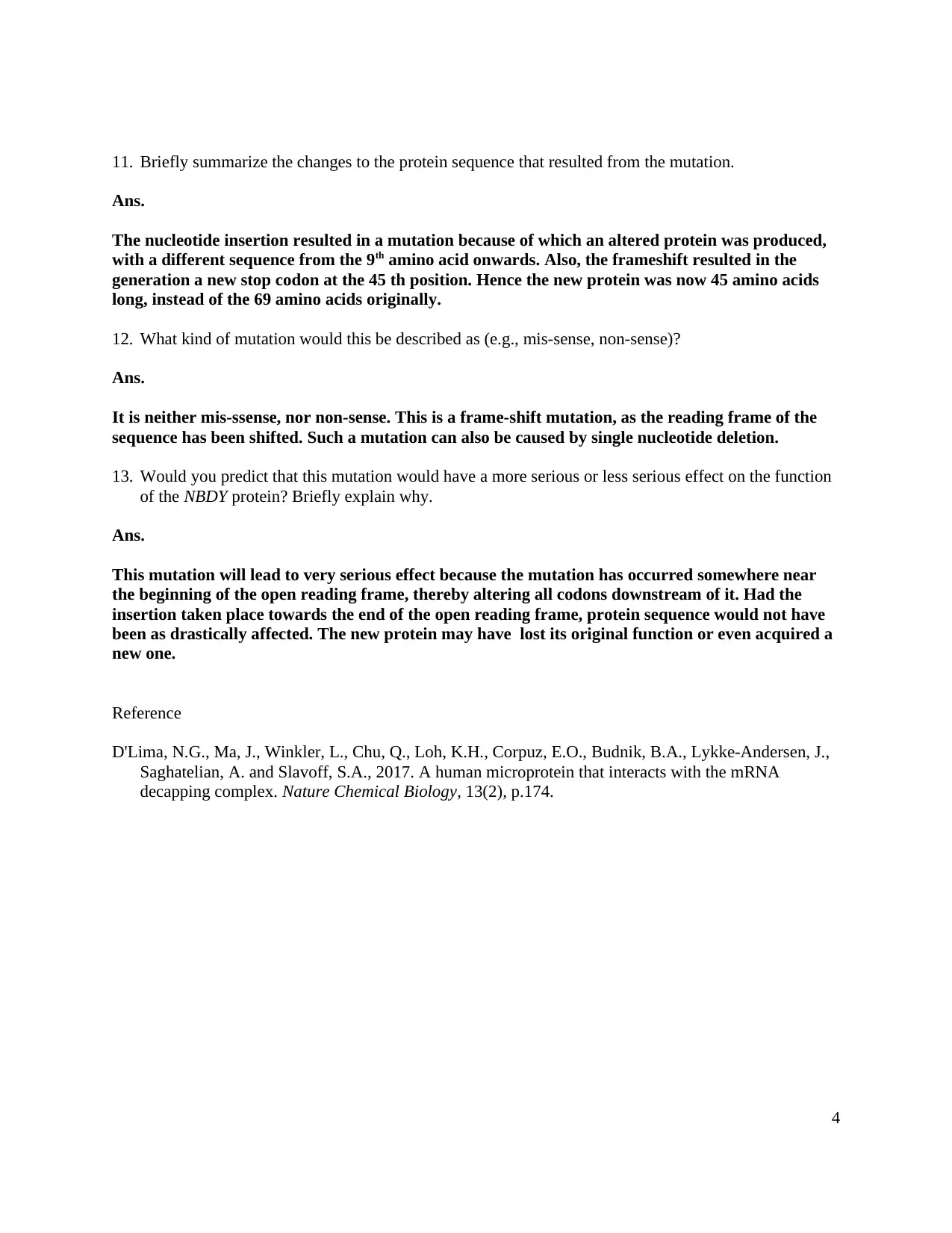Introduction to Genetics Assignment 7
VerifiedAdded on 2022/12/28
|4
|1554
|58
AI Summary
This document is Assignment 7 for the Introduction to Genetics course. It discusses mutations in the NBDY gene and their effects on the protein sequence. The document includes examples of different types of mutations and their impact on protein function.
Contribute Materials
Your contribution can guide someone’s learning journey. Share your
documents today.

--
Name: _____________________________________ BIOLOGY 251 – Introduction to Genetics
Assignment 7 – Spring 2019
You might want to complete this assignment electronically, using copy and paste features on your word
processing program. There are online resources (e.g., https://web.expasy.org/translate/) where you can
type in a nucleotide sequence and recover an amino acid sequence. Read the directions carefully and
complete all tasks that are indicated. You may turn in your completed assignment electronically to
Canvas, or by printing it out and handing it in.
The RNA sequence below represents the coding sequence for a human ‘microprotein’ known as NoBody
(NBDY). The NBDY gene is involved in breaking down mRNA molecules (D’Lima et al., 2017). The
sequence would be found on the mature mRNA. The sequence below begins with a start codon and ends
with a stop codon.
5’–
AUGGGAGACCAACCUUGUGCCUCCGGGAGAUCCACUCUCCCACCUGGAAACGCACGGGAAGCCA
AGCCUCCAAAAAAGCGCUGCCUCCUCGCUCCGCGUUGGGAUUAUCCGGAAGGAACUCCCAACGG
AGGUAGUACCACUCUACCCUCCGCACCUCCUCCUGCAUCAGCCGGCCUGAAGUCGCACCCUCCU
CCUCCGGAGAAGUAG–3’
1. Enter the amino acid sequence for the protein that would be produced from this mRNA.
Ans.
The espressed protein will be a 69 amino-acid long protein with thw following sequence,
considering the current Open Reading Frame:
5’– Met G D Q P C A S G R S T L P P G N A R E A K P P K K R C L L A P R W D Y P E G T P N G G S
T T L P S A P P P A S A G L K S H P P P P E K Stop–3’
The following sequence results from a single nucleotide substitution in the NBDY coding sequence. The
altered nucleotide is underlined.
5’–
AUGGGAGACCAACCUUGAGCCUCCGGGAGAUCCACUCUCCCACCUGGAAACGCACGGGAAGCCA
AGCCUCCAAAAAAGCGCUGCCUCCUCGCUCCGCGUUGGGAUUAUCCGGAAGGAACUCCCAACGG
AGGUAGUACCACUCUACCCUCCGCACCUCCUCCUGCAUCAGCCGGCCUGAAGUCGCACCCUCCU
CCUCCGGAGAAGUAG–3’
2. Enter the amino acid sequence for the protein that would be produced from this mRNA.
Ans.
The single nucleotide substitution has resulted in changing the codon UGU (for Cystine) to UGA
( a STOP codon). As a result, the new mRNA sequence results in a truncated peptide of only 5
amino acids. The sequence will be:
5’–Met G D Q P Stop–3’.
1
Name: _____________________________________ BIOLOGY 251 – Introduction to Genetics
Assignment 7 – Spring 2019
You might want to complete this assignment electronically, using copy and paste features on your word
processing program. There are online resources (e.g., https://web.expasy.org/translate/) where you can
type in a nucleotide sequence and recover an amino acid sequence. Read the directions carefully and
complete all tasks that are indicated. You may turn in your completed assignment electronically to
Canvas, or by printing it out and handing it in.
The RNA sequence below represents the coding sequence for a human ‘microprotein’ known as NoBody
(NBDY). The NBDY gene is involved in breaking down mRNA molecules (D’Lima et al., 2017). The
sequence would be found on the mature mRNA. The sequence below begins with a start codon and ends
with a stop codon.
5’–
AUGGGAGACCAACCUUGUGCCUCCGGGAGAUCCACUCUCCCACCUGGAAACGCACGGGAAGCCA
AGCCUCCAAAAAAGCGCUGCCUCCUCGCUCCGCGUUGGGAUUAUCCGGAAGGAACUCCCAACGG
AGGUAGUACCACUCUACCCUCCGCACCUCCUCCUGCAUCAGCCGGCCUGAAGUCGCACCCUCCU
CCUCCGGAGAAGUAG–3’
1. Enter the amino acid sequence for the protein that would be produced from this mRNA.
Ans.
The espressed protein will be a 69 amino-acid long protein with thw following sequence,
considering the current Open Reading Frame:
5’– Met G D Q P C A S G R S T L P P G N A R E A K P P K K R C L L A P R W D Y P E G T P N G G S
T T L P S A P P P A S A G L K S H P P P P E K Stop–3’
The following sequence results from a single nucleotide substitution in the NBDY coding sequence. The
altered nucleotide is underlined.
5’–
AUGGGAGACCAACCUUGAGCCUCCGGGAGAUCCACUCUCCCACCUGGAAACGCACGGGAAGCCA
AGCCUCCAAAAAAGCGCUGCCUCCUCGCUCCGCGUUGGGAUUAUCCGGAAGGAACUCCCAACGG
AGGUAGUACCACUCUACCCUCCGCACCUCCUCCUGCAUCAGCCGGCCUGAAGUCGCACCCUCCU
CCUCCGGAGAAGUAG–3’
2. Enter the amino acid sequence for the protein that would be produced from this mRNA.
Ans.
The single nucleotide substitution has resulted in changing the codon UGU (for Cystine) to UGA
( a STOP codon). As a result, the new mRNA sequence results in a truncated peptide of only 5
amino acids. The sequence will be:
5’–Met G D Q P Stop–3’.
1
Secure Best Marks with AI Grader
Need help grading? Try our AI Grader for instant feedback on your assignments.

3. Briefly summarize the changes to the protein sequence that resulted from the mutation.
Ans.
The mutation resulted in the synthesis of truncated penta-peptide instead of the native protein of 69
aminoacids as the translation of mRNA stopped after 5 amino acids were incorporated due to
presence of a stop codon UGA (highlighted in above sequence) instead of UGU (present in the
original sequence).
4. What kind of mutation would this be described as (e.g., missense, nonsense)?
Ans.
This is a non-sense mutation and not a mis-sense one. This is because, by definition – a mutation
that causes a codon to change such that the new codon now codes for another amino-acid, is known
as a mis-sense mutation. Eg: TGG (for Tryptophan) changing to TGT (for Cystine).
On the other hand, a mutation that causes a codon to change such that the new codon does not code
for any of the amino acids , is known as a no-sense mutation. These mutations result in abrupt
chain termination as they act as STOP signals. Any of following three codons result in non-sense
mutations: UAA, UAG, UGA.
5. Would you predict that this mutation would have a more serious or less serious effect on the function
of the NBDY protein? Briefly explain why.
Ans.
This mutation will lead to a very serious effect on the function of the protein because the protein
will not get synthesized completely. A truncated protein of six five amino acids will be non-
functional.
The following sequence results from a single nucleotide substitution in the NBDY coding sequence. The
altered nucleotide is underlined.
5’–
AUGGGAGACCAACCUUGUGCCUUCGGGAGAUCCACUCUCCCACCUGGAAACGCACGGGAAGCCA
AGCCUCCAAAAAAGCGCUGCCUCCUCGCUCCGCGUUGGGAUUAUCCGGAAGGAACUCCCAACGG
AGGUAGUACCACUCUACCCUCCGCACCUCCUCCUGCAUCAGCCGGCCUGAAGUCGCACCCUCCU
CCUCCGGAGAAGUAG–3’
6. Enter the amino acid sequence for the protein that would be produced from this mRNA.
Ans.
The new amino acid sequence due to the change from UCC to UUC will be:
5’- Met G D Q P C A F G R S T L P P G N A R E A K P P K K R C L L A P R W D Y P E G T P N G G
S T T L P S A P P P A S A G L K S H P P P P E K Stop -3’
2
Ans.
The mutation resulted in the synthesis of truncated penta-peptide instead of the native protein of 69
aminoacids as the translation of mRNA stopped after 5 amino acids were incorporated due to
presence of a stop codon UGA (highlighted in above sequence) instead of UGU (present in the
original sequence).
4. What kind of mutation would this be described as (e.g., missense, nonsense)?
Ans.
This is a non-sense mutation and not a mis-sense one. This is because, by definition – a mutation
that causes a codon to change such that the new codon now codes for another amino-acid, is known
as a mis-sense mutation. Eg: TGG (for Tryptophan) changing to TGT (for Cystine).
On the other hand, a mutation that causes a codon to change such that the new codon does not code
for any of the amino acids , is known as a no-sense mutation. These mutations result in abrupt
chain termination as they act as STOP signals. Any of following three codons result in non-sense
mutations: UAA, UAG, UGA.
5. Would you predict that this mutation would have a more serious or less serious effect on the function
of the NBDY protein? Briefly explain why.
Ans.
This mutation will lead to a very serious effect on the function of the protein because the protein
will not get synthesized completely. A truncated protein of six five amino acids will be non-
functional.
The following sequence results from a single nucleotide substitution in the NBDY coding sequence. The
altered nucleotide is underlined.
5’–
AUGGGAGACCAACCUUGUGCCUUCGGGAGAUCCACUCUCCCACCUGGAAACGCACGGGAAGCCA
AGCCUCCAAAAAAGCGCUGCCUCCUCGCUCCGCGUUGGGAUUAUCCGGAAGGAACUCCCAACGG
AGGUAGUACCACUCUACCCUCCGCACCUCCUCCUGCAUCAGCCGGCCUGAAGUCGCACCCUCCU
CCUCCGGAGAAGUAG–3’
6. Enter the amino acid sequence for the protein that would be produced from this mRNA.
Ans.
The new amino acid sequence due to the change from UCC to UUC will be:
5’- Met G D Q P C A F G R S T L P P G N A R E A K P P K K R C L L A P R W D Y P E G T P N G G
S T T L P S A P P P A S A G L K S H P P P P E K Stop -3’
2

7. Briefly summarize the changes to the protein sequence that resulted from the mutation.
Ans.
This single nucleotide substitution from C to U has resulted in a change in amino acid where Serine
(S in original sequene) is replaced by Phenylalanine (F in above sequence). Such a change from a
polar, uncharged and small R chain to hydrophobic and larger R group may result in changes in
the proteins folding and 3D structure. These changes can change the functional aspects of the
protein too.
8. What kind of mutation would this be described as (e.g., missense, nonsense)?
Ans.
This is a mis-sense mutation, as the nucleotide change causes the codon to change the type of amino
acid it codes for. A non-sense mutation would have resulted in chain termination due to formation
of a STOP signal codon.
9. Would you predict that this mutation would have a more serious or less serious effect on the function
of the NBDY protein? Briefly explain why.
Ans.
This mutation might have a serious effect as serine which is a polar uncharged side chain amino
acid is getting replaced by phenylalanine- a hyprobhobic side chain amino acid. This change may
change the intra- chain interactions between the amino-acids. Hence, the protein strucrure, possibly
that of the acive site or interactive domains of the protein may change. Depending on the extent of
structural changes, the effect may be more or less sevre.
The following sequence results from an insertion of one nucleotide in the NBDY coding sequence. The
inserted nucleotide is underlined.
5’–
AUGGGAGACCAACCUUGUGCCUCCGGCGAGAUCCACUCUCCCACCUGGAAACGCACGGGAAGCC
AAGCCUCCAAAAAAGCGCUGCCUCCUCGCUCCGCGUUGGGAUUAUCCGGAAGGAACUCCCAACG
GAGGUAGUACCACUCUACCCUCCGCACCUCCUCCUGCAUCAGCCGGCCUGAAGUCGCACCCUCC
UCCUCCGGAGAAGUAG–3’
10. Enter the amino acid sequence for the protein that would be produced from this mRNA.
Ans.
The sequence of the protein till the first 8 amino acids from the N terminal are same. However,
due to insertional mutation at this point, an extra C is inserted after the 26th nucleotide. As a result
a change in the reading frame from the 9th amino acid onwards takes place. The new sequence is
as follows:
5’– Met G D Q P C A S G E I H S P T W K R T G S Q A S K K A L P P R S A L G L S G R N S Q R
R Stop–3’
3
Ans.
This single nucleotide substitution from C to U has resulted in a change in amino acid where Serine
(S in original sequene) is replaced by Phenylalanine (F in above sequence). Such a change from a
polar, uncharged and small R chain to hydrophobic and larger R group may result in changes in
the proteins folding and 3D structure. These changes can change the functional aspects of the
protein too.
8. What kind of mutation would this be described as (e.g., missense, nonsense)?
Ans.
This is a mis-sense mutation, as the nucleotide change causes the codon to change the type of amino
acid it codes for. A non-sense mutation would have resulted in chain termination due to formation
of a STOP signal codon.
9. Would you predict that this mutation would have a more serious or less serious effect on the function
of the NBDY protein? Briefly explain why.
Ans.
This mutation might have a serious effect as serine which is a polar uncharged side chain amino
acid is getting replaced by phenylalanine- a hyprobhobic side chain amino acid. This change may
change the intra- chain interactions between the amino-acids. Hence, the protein strucrure, possibly
that of the acive site or interactive domains of the protein may change. Depending on the extent of
structural changes, the effect may be more or less sevre.
The following sequence results from an insertion of one nucleotide in the NBDY coding sequence. The
inserted nucleotide is underlined.
5’–
AUGGGAGACCAACCUUGUGCCUCCGGCGAGAUCCACUCUCCCACCUGGAAACGCACGGGAAGCC
AAGCCUCCAAAAAAGCGCUGCCUCCUCGCUCCGCGUUGGGAUUAUCCGGAAGGAACUCCCAACG
GAGGUAGUACCACUCUACCCUCCGCACCUCCUCCUGCAUCAGCCGGCCUGAAGUCGCACCCUCC
UCCUCCGGAGAAGUAG–3’
10. Enter the amino acid sequence for the protein that would be produced from this mRNA.
Ans.
The sequence of the protein till the first 8 amino acids from the N terminal are same. However,
due to insertional mutation at this point, an extra C is inserted after the 26th nucleotide. As a result
a change in the reading frame from the 9th amino acid onwards takes place. The new sequence is
as follows:
5’– Met G D Q P C A S G E I H S P T W K R T G S Q A S K K A L P P R S A L G L S G R N S Q R
R Stop–3’
3

11. Briefly summarize the changes to the protein sequence that resulted from the mutation.
Ans.
The nucleotide insertion resulted in a mutation because of which an altered protein was produced,
with a different sequence from the 9th amino acid onwards. Also, the frameshift resulted in the
generation a new stop codon at the 45 th position. Hence the new protein was now 45 amino acids
long, instead of the 69 amino acids originally.
12. What kind of mutation would this be described as (e.g., mis-sense, non-sense)?
Ans.
It is neither mis-ssense, nor non-sense. This is a frame-shift mutation, as the reading frame of the
sequence has been shifted. Such a mutation can also be caused by single nucleotide deletion.
13. Would you predict that this mutation would have a more serious or less serious effect on the function
of the NBDY protein? Briefly explain why.
Ans.
This mutation will lead to very serious effect because the mutation has occurred somewhere near
the beginning of the open reading frame, thereby altering all codons downstream of it. Had the
insertion taken place towards the end of the open reading frame, protein sequence would not have
been as drastically affected. The new protein may have lost its original function or even acquired a
new one.
Reference
D'Lima, N.G., Ma, J., Winkler, L., Chu, Q., Loh, K.H., Corpuz, E.O., Budnik, B.A., Lykke-Andersen, J.,
Saghatelian, A. and Slavoff, S.A., 2017. A human microprotein that interacts with the mRNA
decapping complex. Nature Chemical Biology, 13(2), p.174.
4
Ans.
The nucleotide insertion resulted in a mutation because of which an altered protein was produced,
with a different sequence from the 9th amino acid onwards. Also, the frameshift resulted in the
generation a new stop codon at the 45 th position. Hence the new protein was now 45 amino acids
long, instead of the 69 amino acids originally.
12. What kind of mutation would this be described as (e.g., mis-sense, non-sense)?
Ans.
It is neither mis-ssense, nor non-sense. This is a frame-shift mutation, as the reading frame of the
sequence has been shifted. Such a mutation can also be caused by single nucleotide deletion.
13. Would you predict that this mutation would have a more serious or less serious effect on the function
of the NBDY protein? Briefly explain why.
Ans.
This mutation will lead to very serious effect because the mutation has occurred somewhere near
the beginning of the open reading frame, thereby altering all codons downstream of it. Had the
insertion taken place towards the end of the open reading frame, protein sequence would not have
been as drastically affected. The new protein may have lost its original function or even acquired a
new one.
Reference
D'Lima, N.G., Ma, J., Winkler, L., Chu, Q., Loh, K.H., Corpuz, E.O., Budnik, B.A., Lykke-Andersen, J.,
Saghatelian, A. and Slavoff, S.A., 2017. A human microprotein that interacts with the mRNA
decapping complex. Nature Chemical Biology, 13(2), p.174.
4
1 out of 4
Related Documents
Your All-in-One AI-Powered Toolkit for Academic Success.
+13062052269
info@desklib.com
Available 24*7 on WhatsApp / Email
![[object Object]](/_next/static/media/star-bottom.7253800d.svg)
Unlock your academic potential
© 2024 | Zucol Services PVT LTD | All rights reserved.




